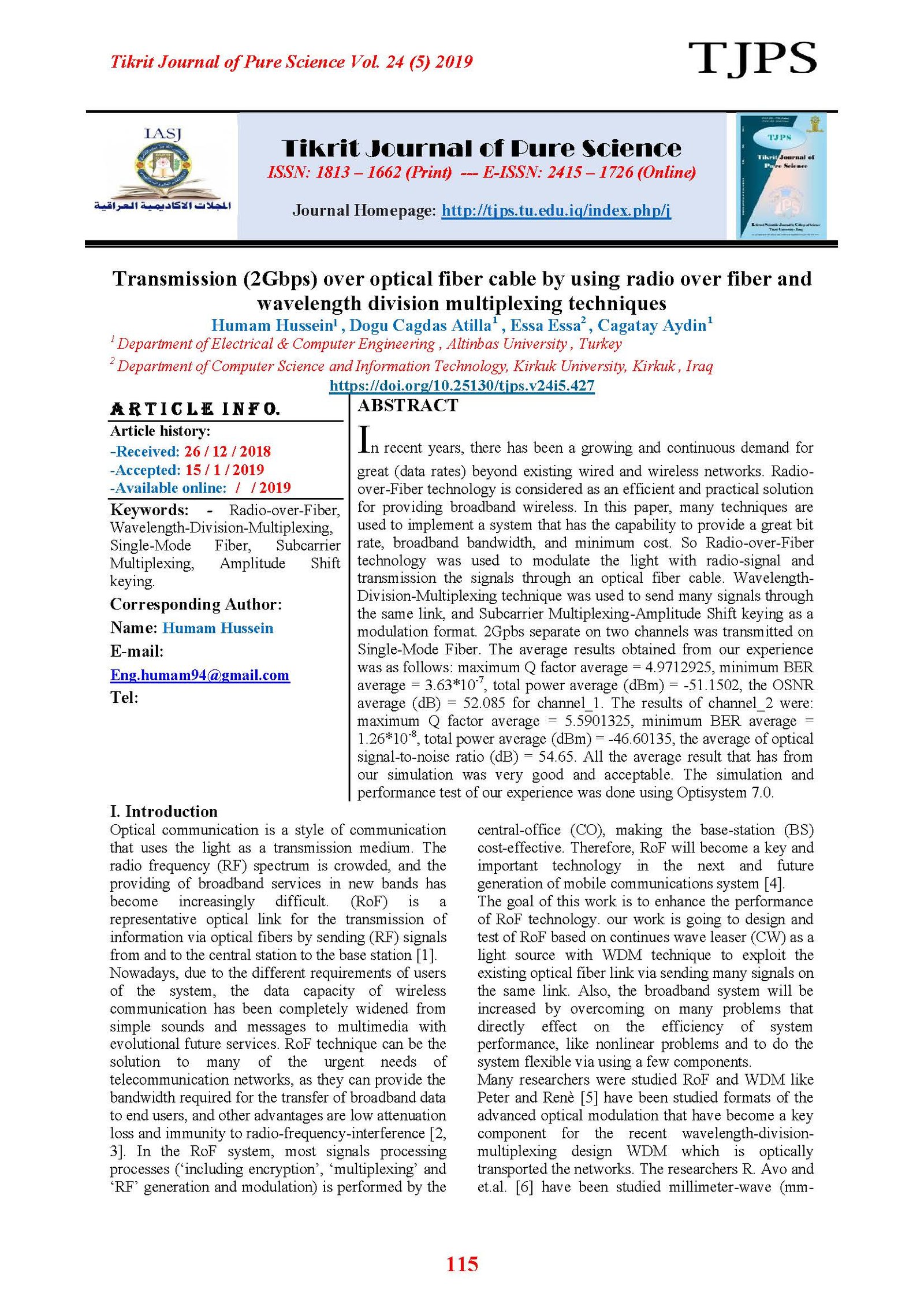Transmission (2Gbps) over optical fiber cable by using radio over fiber and wavelength division multiplexing techniques
Main Article Content
Abstract
In recent years, there has been a growing and continuous demand for great (data rates) beyond existing wired and wireless networks. Radio-over-Fiber technology is considered as an efficient and practical solution for providing broadband wireless. In this paper, many techniques are used to implement a system that has the capability to provide a great bit rate, broadband bandwidth, and minimum cost. So Radio-over-Fiber technology was used to modulate the light with radio-signal and transmission the signals through an optical fiber cable. Wavelength-Division-Multiplexing technique was used to send many signals through the same link, and Subcarrier Multiplexing-Amplitude Shift keying as a modulation format. 2Gpbs separate on two channels was transmitted on Single-Mode Fiber. The average results obtained from our experience was as follows: maximum Q factor average = 4.9712925, minimum BER average = 3.63*10-7, total power average (dBm) = -51.1502, the OSNR average (dB) = 52.085 for channel_1. The results of channel_2 were: maximum Q factor average = 5.5901325, minimum BER average = 1.26*10-8, total power average (dBm) = -46.60135, the average of optical signal-to-noise ratio (dB) = 54.65. All the average result that has from our simulation was very good and acceptable. The simulation and performance test of our experience was done using Optisystem 7.0.
Article Details

This work is licensed under a Creative Commons Attribution 4.0 International License.
Tikrit Journal of Pure Science is licensed under the Creative Commons Attribution 4.0 International License, which allows users to copy, create extracts, abstracts, and new works from the article, alter and revise the article, and make commercial use of the article (including reuse and/or resale of the article by commercial entities), provided the user gives appropriate credit (with a link to the formal publication through the relevant DOI), provides a link to the license, indicates if changes were made, and the licensor is not represented as endorsing the use made of the work. The authors hold the copyright for their published work on the Tikrit J. Pure Sci. website, while Tikrit J. Pure Sci. is responsible for appreciate citation of their work, which is released under CC-BY-4.0, enabling the unrestricted use, distribution, and reproduction of an article in any medium, provided that the original work is properly cited.
References
[1]Smith, G.H; Novak, M. and Lim, C. (1998). A millimeter-wave full-duplex fiber-radio star-tree architecture incorporating WDM and SCM. IEEE Photonics Technology Letters, 10 (11):1650-1652.
[2]Nasoha, H. and Idrus, S. M. (2007). Modeling and performance analysis of WCDMA radio over fiber system. APACE Asia-Pacific Conference on Applied Electromagnetics, 4-6 Dec 2007, Melaka, Malaysia. University Technology of Malaysia: p. 1-4.
[3]Nirmalathas, A.; Gamage, P. A.; Lim, C.; Novak, D. and Waterhouse, R. (2010). Digitized radio-over-fiber technologies for converged optical wireless access network. Journal of Lightwave Technology, 28 (16):2366-2375.
[4]Sasai, H; Niiho, T.; Tanaka, K.; Utsumi, K. and Morikura, S. (2003). Radio-over-fiber transmission performance of OFDM signal for dual-band wireless LAN systems. International Topical Meeting on Microwave Photonics, 10-12 Sep 2003, Budapest, Hungary. Budapest University: p. 139-142.
[5]Winzer, P. J. and Essiambre, R.-J. (2006). Advanced modulation formats for high-capacity optical transport networks. Journal of Lightwave Technology, 24 (12):4711-4728
[6]Avo, R.; Laurencio, P. and Medeiros, M. (2010). 60 GHz radio-over-fiber transmission impairments for broadband wireless signals. 12th International Conference on Transparent Optical Networks, 27 June-1 July 2010, Munich, Germany. Technical University of Munich: p. 1-4.
[7]Revathi, S. and Aarthi, G. (2014). Performance analysis of Wave Length Division and Sub Carrier Multiplexing using different modulation techniques. International Journal for Engineering Research and Application, 1 (2):317-320.
[8]Thomas, V. A.; El-Hajjar, M. and Hanzo, L. (2015). Performance improvement and cost reduction techniques for radio over fiber communications. IEEE Communications Surveys & Tutorials, 17 (2):627-670.
[9]Kaur, S.; Srivastava, M. and Bhatia, K. S. (2015). Radio over Fiber Technology–A Review. in International Conference of Technology, Management and Social Sciences, 5 (7):85-88.
[10]Zhang, L. et al. (2010) .OFDM modulated WDM-ROF system based on PCF-supercontinuum. Optics express, 18 (14):15003-15008.
[11]Ng'oma, A. (2005). Radio-over-fibre technology for broadband wireless communication systems. Ph.D. thesis, Eindhoven University of Technology, Eindhoven, Netherlands: 171 pp.
[12]Pooja, M.; Saroj, S. and Manisha, B. (2015). Advantages and limitations of radio over fiber system. International Journal of Computer Science and Mobile Computing, 4 (5):506-511.
[13]Al Noor, M. (2012). Green radio communication networks applying radio-over-fibre technology for wireless access. Ph.D, thesis, Middlesex University, London, United Kingdom: 197 pp.
[14] Canadian company. (2008). Component Library OptiSys_Design Optical Communication System Design Software. Ottawa, Canada. Available from: https://optiwave.com/.
